The Consumer Price Index increased 0.3% for June, as gasoline increased by 3.4%. Eggs are the new gold as prices had a one month spike not seen since 1973. Energy overall was up 1.7%. Inflation without food or energy prices considered increased 0.2% for the month on soaring shelter costs. From a year ago overall inflation has increased 0.1%. CPI measures inflation, or price increases.

The flat yearly inflation is shown in the below graph as the past decline in gasoline prices really gave a break to consumers, yet that is clearly over.

Core inflation, or CPI with all food and energy items removed from the index, has increased 1.8% for the last year. Core CPI is one of the Federal Reserve inflation watch numbers and 2.0% per year is their target rate. The Fed watches other inflation figures as well as GDP and employment statistics on deciding when to raise rates. Graphed below is the core inflation change from a year ago.
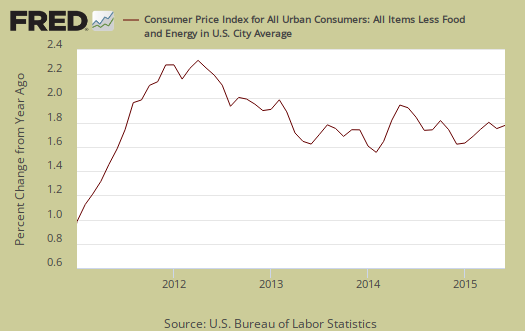
Core CPI's monthly percentage change is graphed below. This month core inflation increased 0.2%, as rents and the owner's equivalent of rent increased 0.4%, a rate not seen since 2013 and 2006 respectively. Lodging away from home, i.e. hotels, motels dropped -1.6% for the month.

The energy index is still down -15% from a year ago. The BLS separates out all energy costs and puts them together into one index. For the year, gasoline has declined -23.2%, while Fuel oil has dropped -27.7%. Natural gas has dropped -13.3% while Electricity is unchanged from a year ago. From a year ago national gas prices have declined -15.4% and electricity is still very tame, with a 0.5% increase. Energy is still on the rise as the only component to drop for the month was fuel, 1.9% Graphed below is the overall CPI energy index.
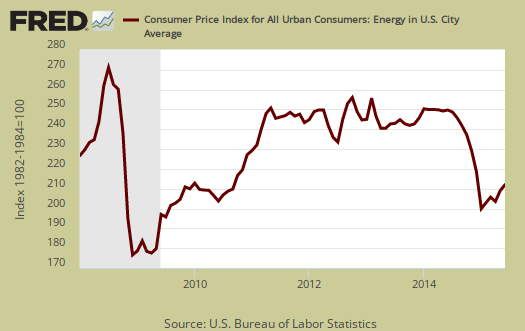
Graphed below is the CPI gasoline index only, which shows gas prices wild ride and recent increases.
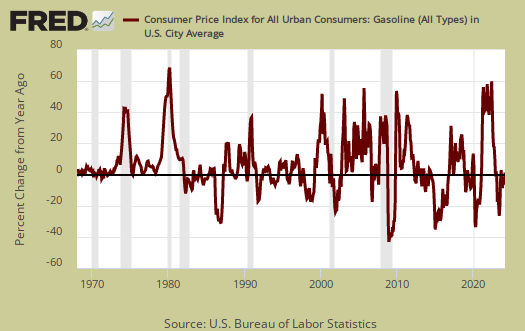
Core inflation's components include shelter, transportation, medical care and anything that is not food or energy. The shelter index is comprised of rent, the equivalent cost of owning a home, hotels and motels. Shelter increased 0.2% and is up 2.9% for the year. Rent increased 0.3% for the month, 3.5% for the year. Graphed below is the rent price index.

Medical care services decreased -0.2% and has increased 2.3%. Graphed below is the overall medical care index change of 2.5% from a year ago.
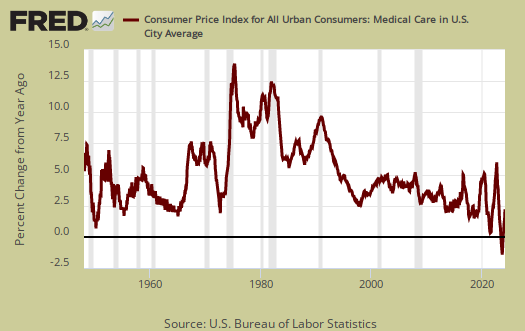
Below is a graph of the medical commodities index, which is mostly prescription drug prices. The index had no change for the month and is up 3.3% for the past year.

Food prices increased 0.3% for the month. Food and beverages have now increased 1.8% from a year ago. Groceries, (called food at home by BLS), increased 0.4% for the month, and are up 1.0% for the year. Eating out, or food away from home increased 0.2% from last month and is up 3.0% from a year ago. Anyone claiming cheap gas somehow decreased food prices hasn't been paying attention. Even with food substitution this year has been awful for meat lovers.

Graphed below are groceries, the food at home index. CPI is calculated using substitution, which claims consumers substitute hamburger for steak if prices rise on steak and somehow that's the same thing. Beef overall has increased 10.9% from a year ago.
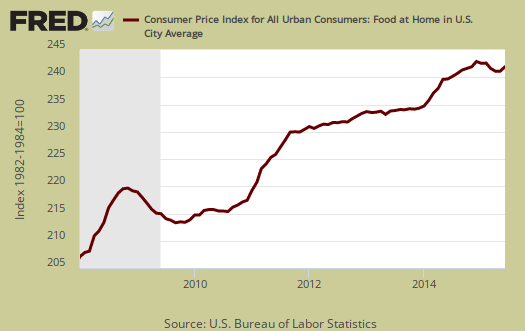
Eggs are just a horror story as prices rose 18.3% in a month. This is the largest egg jump since 1973. Bird flu is to blame as flocks are culled to prevent infection. Eggs are now up 21.8% from a year ago.
Real hourly earnings decreased by -0.4% for all employees. Real means wages adjusted for inflation and since CPI increased 0.3% and wages of course did not, the real value of those wages dropped. For the year real hourly earnings have increased 1.7%, for now staying ahead of the game on inflation but that won't last. The average real wage is now $10.49. Weekly real earnings decreased -0.3% for the month. Real weekly earnings now stand at $362.00.
CPI details
The DOL/BLS does take yearly surveys on where the money goes in the monthly budget, but as one can see, food and energy are significant amounts of the monthly finances. Run away costs in these two areas can break the bank, so can food. Additionally CPI uses substitution, so if flour goes through the roof, somehow we're all just fine with oats and prices didn't really overall increase much. Here is the BLS CPI site, where one can find much more details, information on calculation methods and error margins.
Other CPI report overviews, unrevised, although most graphs are updated, are here. If you're wondering why the graphs display different figures from the text, the graphs calculate percentages from the index and do not round. The actual data from the BLS report does round to one decimal place. In other words, 0.05% is rounded to 0.1%.

Recent comments